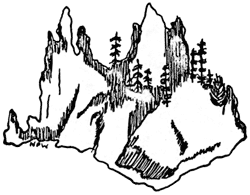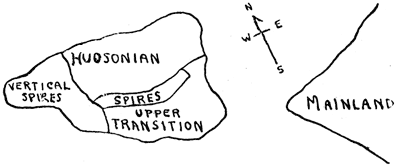Floral Life Zone on the Phantom Ship
By William E. Bush, Ranger-Naturalist
Among the scenic attractions at Crater Lake, few excel in popular appeal or give rise to greater exercise of creative imagination than the small island known as the Phantom Ship. This rugged little island with its spires of andesite, is generally considered to be no more than a picturesque old rock, furnishing appealing subject for those who would use it as vehicle for their contemplations in fantasy by way of mind, palette, or film. Actually, time is fashioning a biological unit on the island; the usual sequences and consequences of nature are molding discernible, competitive boundaries and patterns of adaptation upon its rugged surface.
Physically, the Phantom Ship is a remaining section of the filled conduit of a fissure from which probably poured many of the lower layers of lava constituting Dutton Cliff. Its rocks of pyroxene andesite have in many places been altered by hydrothermal activity. Quartz filled seems give the rock a character uncommon to most of the rocks generally found on the crater walls. The island is about 500 feet long and reaches a maximum width of 200 feet near the east end. Its east-west ridge of spires, towering 170 feet above the water, sharply divides most of the island into two slopes, one very steeply sloping to the south and the other less steeply to the north. The island is separated from the mainland by a shallow channel about 200 feet wide. Above this channel, Dutton Cliff rises abruptly, constituting one of the highest sections of the south-west wall of the caldera.
Observations noted herein were made during two visits to the island on August 8 and August 19, 1946. Some hours were spent in perusal of the situation as it existed, but the plant tally was made on the second visit only. The listings are not to be considered as complete and certainly it will be worthwhile to make additions and corrections as subsequent observations suggest.
The accompanying sketch illustrates roughly the bio-geographic layout of the island. The west end of the island is made up of tall spires which rise vertically; a limited talus at the water’s edge is all that lies between the spires and the water. In this region, few plants have gained a foothold and the area must be essentially classified as barren.
The remainder of the island is divided into two slopes which show a definite segregation of species. White bark pine grows on both slopes in nearly equal areal density, though it appears to be much more in its element on the north side.



